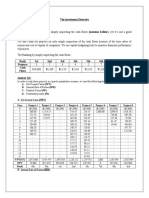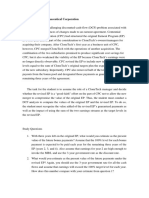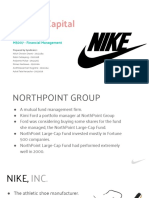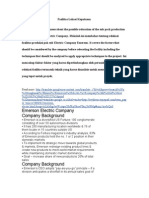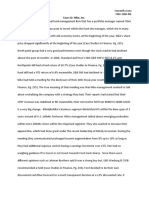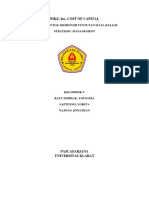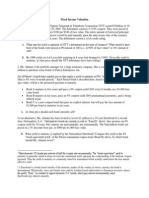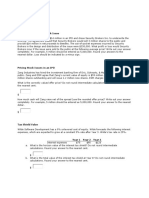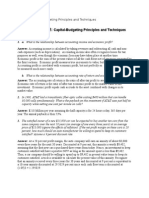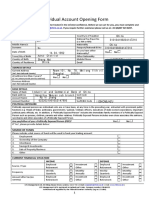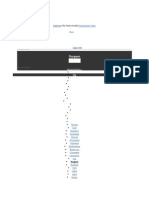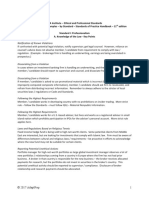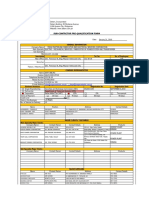rP
os
t
UV0072
Version 2.2
THE INVESTMENT DETECTIVE
op
yo
The essence of capital budgeting and resource allocation is a search for good investments in
which to place the firms capital. The process can be simple when viewed in purely mechanical
terms, but a number of subtle issues can obscure the best investment choices. The capital-budgeting
analyst, therefore, is necessarily a detective who must winnow bad evidence from good. Much of the
challenge is in knowing what quantitative analysis to generate in the first place.
Suppose you are a new capital-budgeting analyst for a company considering investments in
the eight projects listed in Exhibit 1. The chief financial officer of your company has asked you to
rank the projects and recommend the four best that the company should accept.
In this assignment, only the quantitative considerations are relevant. No other project
characteristics are deciding factors in the selection, except that management has determined that
projects 7 and 8 are mutually exclusive.
tC
All the projects require the same initial investment, $2 million. Moreover, all are believed to
be of the same risk class. The firms weighted average cost of capital has never been estimated. In
the past, analysts have simply assumed that 10% was an appropriate discount rate (although certain
officers of the company have recently asserted that the discount rate should be much higher).
To stimulate your analysis, consider the following questions:
1. Can you rank the projects simply by inspecting the cash flows?
No
2. What criteria might you use to rank the projects? Which quantitative ranking methods are
better? Why?
3. What is the ranking you found by using quantitative methods? Does this ranking differ from
the ranking obtained by simple inspection of the cash flows?
Do
4. What kinds of real investment projects have cash flows similar to those in Exhibit 1?
This case was prepared by Robert F. Bruner, with the permission of Professor Gordon Donaldson, the author of an
antecedent case. It was written as a basis for class discussion rather than to illustrate effective or ineffective handling of
an administrative situation. Copyright 1988 by the University of Virginia Darden School Foundation, Charlottesville,
VA. All rights reserved. To order copies, send an e-mail to sales@dardenpublishing.com. No part of this publication may
be reproduced, stored in a retrieval system, used in a spreadsheet, or transmitted in any form or by any means
electronic, mechanical, photocopying, recording, or otherwisewithout the permission of the Darden School
Foundation. Rev. 10/05.
This document is authorized for educator review use only by Muhammad Ajmal, HE OTHER until February 2016. Copying or posting is an infringement of copyright.
Permissions@hbsp.harvard.edu or 617.783.7860
�UV0072
Exhibit 1
rP
os
t
-2-
THE INVESTMENT DETECTIVE
Projects Free Cash Flows
(dollars in thousands)
Initial investment
$(2,000)
$(2,000)
$(2,000)
Year
$ 330
330
330
330
330
330
330*
$ 1,000
$ 1,666
334*
165
1
2
3
4
5
6
7
8
9
10
11
12
13
14
15
Sum of cash flow
benefits
Excess of cash flow
over initial
investment
$(2,000)
$(2,000)
$(2,000)
$(2,000)
$(2,000)
$ 160
200
350
395
432
440*
442
444
446
448
450
451
451
452
$(2,000)
$ 280
280
280
280
280
280
280
280*
280
280
280
280
280
280
$ 280
$ 2,200*
$ 1,200
900*
300
90
70
$ (350)
(60)
60
350
700
1,200
$2,250*
op
yo
$10,000*
tC
Project number:
$ 3,310
$ 2,165
$10,000
$ 3,561
$4,200
$2,200
$ 2,560
$4,150
$ 1,310
$ 8,000
$ 1,561
$2,200
$ 200
$ 560
$2,150
165
Do
No
* Indicates year in which payback was accomplished.
This document is authorized for educator review use only by Muhammad Ajmal, HE OTHER until February 2016. Copying or posting is an infringement of copyright.
Permissions@hbsp.harvard.edu or 617.783.7860

